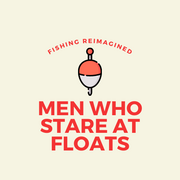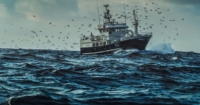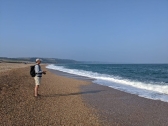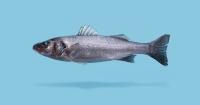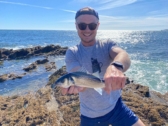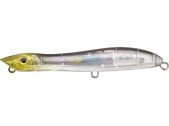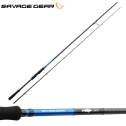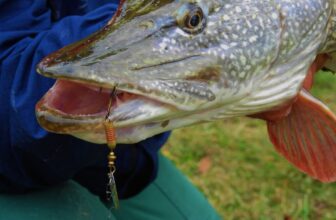Bass are creatures of habit. Like you and I they tend to follow very specific patterns of behaviour that are driven by prevailing tidal and weather conditions. Of course, they’re affected more by changes in barometric pressure and prevailing winds than we are. But when conditions aren’t suitable to hunt in certain areas, they’ll move on to option two, three or four. You can find more top UK bass fishing tips here.
Your understanding of weather conditions is vital in becoming a competent bass fisherman. It is complicated, there’s no two ways about it. But the key thing to remember is you can’t catch anything unless you’re out there and every location is slightly different. What works in one place may not work in another. Whilst the peak spring tide and low pressure may work brilliantly in one mark, the same conditions may bring blank after blank. That’s the beauty of bass fishing. Or any fishing for that matter.

The below should be a good introductory guide to the best conditions for bass fishing. We’ve broken down how the tide, wind, pressure and prevailing weather conditions all impact your ability to catch a beautiful bass. Brexit or not this European creature is more than welcome in our waters.
A 2023 Guide to the UK fishing industry
Bass fishing and the tide
The tide is an important consideration when searching for some sweet bass. Whilst the easy assumption is that bass feed consistently in all areas at the majority of marks, it isn’t true. There are a number of factors you need to consider when trying to work out what time and tide you should fish for bass;
- The underwater topography
- The volume of water
- Prevalence of bait
- The size of the tide
- The season
Bass are known to hunt in water as shallow as eight inches deep when hunting for crustaceans. In certain marks, this requires the highest spring tides when the water volume is at its peak. In others, the same requirements would be met with a neap tide and a front of high pressure. Hopefully, now you understand the challenge.
How does the tide affect bass fishing?
Bass typically feed an hour on either side of high and low tide as the changing water levels and flow affect bass behaviour and the locations in which they swim and hunt. It’s important to note that it isn’t just bass that is affected by tidal conditions and as their primary sources of food become more active, so do bass.
During high tide areas exposed at low tide are flooded with water and fish like bass are able to hunt in rocky or weed-covered areas typically rich in cover. A prime hunting ground for crustaceans and smaller fish. So bass come into estuaries and shallower areas closer to the shore.
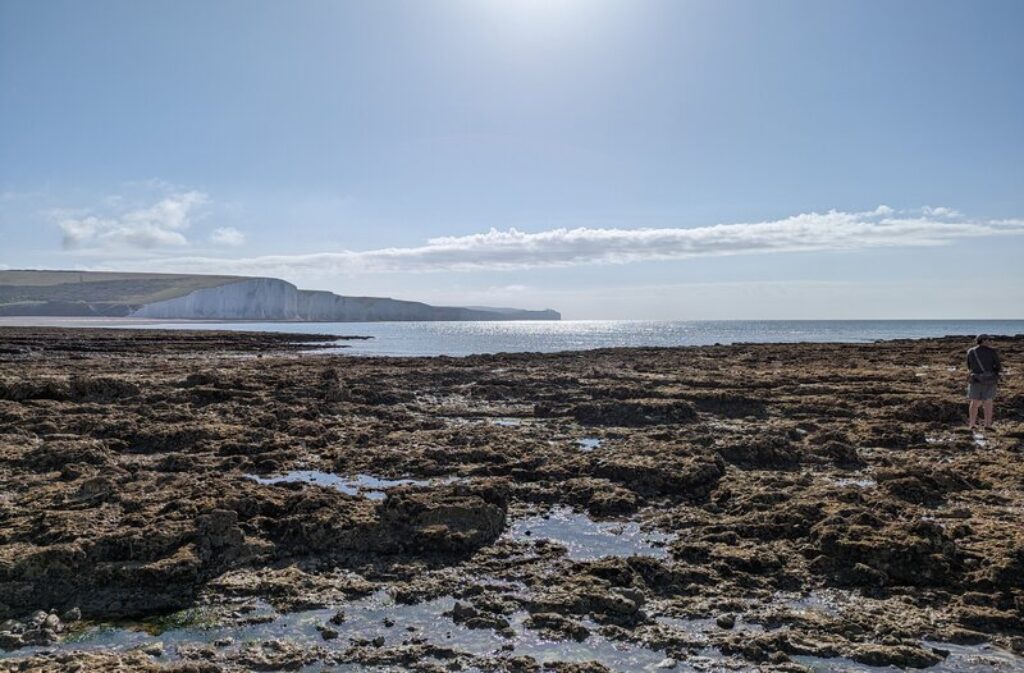
At low tide the inverse is true. As the water level drops it exposes areas that are usually submerged and makes them impossible for bass to hunt. However, it also means there’s less cover for baitfish and crustaceans, making these shallower waters a rich hunting ground for bass.
The tide brings with it a water flow that changes where bass ‘hang out’ and how they behave. On the incoming tide, bass will head towards estuaries, river mouths and shallower areas before making their escape on the ebb. On the outgoing tide, you’re more likely to find bass in areas where the water flows out like sand banks or rocky areas.
The 8 Best Places to Fish for Bass in the UK
What is the best tide to fish for bass?
Typically we find that bass are at their most active on the ebbing tide around one hour on either side of high tide with a 10-minute lull when the tide is at its peak. Whilst the same can be true at low tide it really depends on the area that you’re fishing. If peak high tide covers some rocky areas of prime hunting ground near the shore, then it’s likely high tide will be more prolific. However, if low tide surfaces slightly offshore islands or outcrops then that could be a better opportunity.
Ultimately the underwater topography and volume of water flow dictate whether bass are transient in the areas, moving through quickly, slowly or staying put for longer periods. Powerful water flows (where the sheer volume of water is higher) tend to provide improved bass fishing opportunities.
The peak high and low tide tend to be really poor for bass fishing because conditions become eerily calm for a short period of time. Bass hunt in the wash and swell of waves to cover their approach, so don’t panic if the slack tides feel a little slow.
Bass fishing spring tides
- As a generalisation spring tides tend to fish better for bass in deeper waters
- But they also open up areas too shallow in neap or traditional tides
A spring tide refers to tides that ‘spring’ forth during the new and full moon. Spring tides occur twice each lunar month and are characterised by higher tidal ranges thanks to the gravitational pull of the sun that is ‘added’ when the earth is directly between the moon and the sun. So the high tide is higher and the low tide is lower.
The higher volume of water tends to improve your chances of catching a bass for a couple of reasons. Obviously, spring tides open up shallow, rocky areas of ground rich in crustaceans and baitfish otherwise un-fishable thanks to the extra water volume. But the inverse can also be true.
We’ve found that higher water volumes and more ‘punishing’ conditions tend to encourage the bass to hunt more ferociously. Of course, this is all location-specific, but if you had to pick one tide for bass fishing you’d choose the spring.
Bass fishing neap tides
- Neap tides can make typically shallow areas unfishable
- But can also open up areas that are typically too easy for baitfish and crustaceans to hide
A neap tide is a considerably more moderate tide that occurs seven days after a spring tide when the sun and moon are at right angles to each other. Typically during the first and third quarter moon. A neap tide is characterised by a lower tidal range that makes certain shallower areas too shallow for bass to hunt over, reducing your chances of catching them near the shore.
However neap tides can turn rocky, weed-filled areas, typically too deep for bass to hunt, into prime hunting grounds. So the very high or low of a neap can create more advantageous conditions than the spring’s counterpart when it comes to bass fishing. This just requires local expertise. There are no shortcuts here.
The best time to fish for bass in the UK
Really there is no perfect time to fish for bass, but the majority of marks fish best in the warmer summer months at dawn, dusk or the dead of night. Typically you’ll find that the peak heat or sunshine of the day is not the best time to fish for bass (or most fish) and that larger bass will make their way into shallow, shingle beaches at nighttime.
What’s the best time of year to fish for bass in the UK?
Whilst you can fish for bass all year round in the UK, the late spring to early autumn is the best time to fish for sea bass. July, August and September are our preferred months to target bass. The warmer waters and surplus of bait – crustaceans, baitfish, squid, sand eels et al – create the perfect hunting conditions for bass where they fatten up prior to moving offshore into warmer, deeper waters in winter, with adults returning to inshore waters to spawn in March.
Bass Fishing Rules and Regulations in the UK
In order to keep bass populations healthy recreational fishermen are limited to catch-and-release fishing only during December – February each year. For catch-and-release fishing a maximum of two seabass may be retained each day between March – November.
What month is best to fish for bass in the UK?
July and August tend to be the best months to fish for bass in the UK. Bass return from the deeper offshore waters to spawn inshore when the water temperature begins to increase with the warmer weather. In order to regain weight from the spawning season and prepare for the next one the bass feed on the surplus of baitfish and crustaceans in these months. In the spring months, the majority of crabs start to peel, generating a huge amount of bait for bass.
What’s the best time of day to fish for bass in the UK?
The best time of day does depend on the location, prevailing weather conditions and state of the tide. But if all else equal then typically dawn, dusk and the dead of night provide the perfect conditions for bass fishing in the daytime. The lower light creates excellent hunting conditions as the bass can hunt under cover of dimness thanks to their excellent eyesight.
Ultimately the best time of day to fish for bass is typically going to be an hour or two either side of peak high and low tide when there’s enough light to hunt, but enough cloud cover for bass to hunt in the wash without being seen. If that’s dawn or dusk or the dead of night, then conditions will be as close to perfect as you can get.
A Beginner Guide to Bass Fishing in the UK
Can you catch bass at night in the UK?
Yes, you can catch bass at night in the UK. In fact, nighttime is arguably the best time to catch larger bass from the shore in calmer conditions. Bass – particularly the larger of the species – are wary hunters, so nighttime is the perfect cover to enter the shallows near the shore.
This is particularly prevalent when low or high tide conditions create rocky, weedy shallows of 8-12 inches deep, where peeler crabs and baitfish are hiding. Tossing lures over these marks can be some of the most exciting fishing you can do in UK waters.
As a species, European Sea Bass are slow to mature. The fish reach sexual maturity between 4-8 years of age, with the females peaking slightly later. This slow rate of maturity means that to survive the fish have to be wary. Hence their reluctance to enter waters in conditions where the risk of being spotted is too high.
The 6 Best UK Bass Fishing Lures in 2023 Editor’s choice
Weather and bass fishing in the UK
Much like the tide, time of day the prevailing weather conditions play a role in your success (or lack of it) as a bass fisherman. The temperature, overhead conditions, pressure, wind and rain can all positively or negatively impact bass fishing. And – unfortunately – there are no perfect weather conditions that work in every mark, but there are some key rules to be aware of.
What temperature is best for bass fishing in the UK?
The ideal temperature for bass fishing in the UK varies depending on;
- Location
- Water depth
- Where you’re fishing from (shore or boat)
- Time of year
- Frankly how seriously you want to take it – it should be an enjoyable hobby
As a general rule when the water is warmer bass will be found closer to the shore, moving to deeper waters in the colder winter and spring months, returning to spawn inshore from March onwards. So if you’re fishing from the shore, the warmer months are better for bass fishing. And more enjoyable. If you’re fishing offshore, then colder months can be more effective for bass fishing.
Typically bass are most active when the average sea temperatures go above 12 degrees Celsius. If we take St. Ives as an example, the water is warmest in August with an average of just under 16.9 degrees Celsius and coldest in March with an average water temperature of around 9.4 degrees Celsius. In May the sea temperature climbs to around 12 degrees Celsius and stays above that until November, peaking in August.

Whereas Whitby sea temperatures are around two degrees colder in average, only getting above 12 degrees for around four months of the year. So the further north you are, the shorter your sea bass shore fishing window.
The 7 Best Bass Fishing Rods in 2023
Does rain affect bass fishing in the UK?
Rain- particularly heavy rain – can affect bass fishing because the vibrations and visibility make bait presentation harder. So if you’re lure fishing for bass then heavy rain can make fishing substantially more difficult as sight hunters like bass become less effective.
However light rain can have a positive effect for the very same reason. When the water is too calm, the sound of lures hitting the water and their surrounding vibrations can be too disruptive. So it can mask the initial impact and reduce the chance of you spooking the fish. Particularly when shore fishing where the rain provides cover for you as the angler.
If the rain is too heavy then fishing with sub-surface lures is a good starting point.
Does wind affect bass fishing in the UK?
Wind direction and strength do affect bass fishing in the UK. If the wind is blowing onshore (blowing from the sea towards the land) then the water is likely to be far rougher and can delay the ebbing tide or speed up the flooding process.
If the wind is blowing offshore (from land to sea) it tends to calm the waters and slow down the flooding tide, speeding up the ebb. So if you’re fishing the ebb over a shallow reef with an offshore wind, the period of time you have to fish ebbing ground is reduced.
As the prevailing wind conditions can alter the speed of the ebb and flood you need to be wary in areas where you’ve had to cross channels or gullies so that you don’t get caught out.
Are overcast or cloudy conditions better for sea bass fishing in the UK?
Ask any fisherman and they’ll tell you that fishing in cloudy or overcast conditions is more productive than clear skies and bright sunshine. It’s entirely plausible that bright sunlight makes the bass too easy to see, so they conserve energy by hunting less.
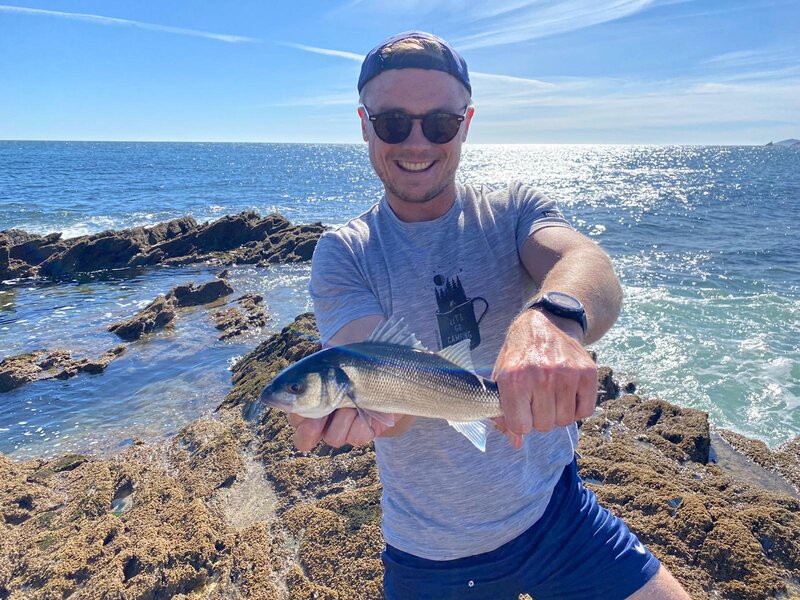
If you’re fishing from a boat in deeper water, then the prevailing sunlight and brightness make less of a difference. When fishing with lures in shallower water, attempting to fish when the water is less clear is a safer bet.
How does barometric pressure affect sea bass fishing?
Higher barometric pressure depresses the water level by 1cm for every 1Mb of additional pressure. By forcing the water down the water volume is essentially reduced, meaning areas typically submerged at standard pressure may no longer be suitable for bass to hunt in the shallows. But the same is true on days of lower pressure. The inflated water level can unearth typically unfishable areas for bass to hunt over.
As tides are measured against a standard barometric pressure of 1013 millibars, changes in pressure can cause fluctuations in tidal height. A difference in one millibar can cause a difference of one cm with lower pressure causing the sea level to rise and high pressure causing a drop. So it stands to reason that pressure changes affect bass fishing.
FAQs
Is bass fishing good at low tide?
Bass fishing can be absolutely brilliant at low tide. Bass are known to hunt in incredibly shallow water (8-12 inches is common) as they hunt for crustaceans and baitfish. If the mark you’re fishing has rocky features exposed to shallow water at low tide it could make for brilliant sea bass fishing.
Can you lure fish for bass at low tide?
Yes, you can lure fish for bass at low tide. Low tide can create some of the very best conditions when lure fishing for bass because bass hunt for crustaceans and baitfish in the shallows. So using lighter surface or slightly sub-surface lures over rocky, baitfish-rich areas can be incredibly effective.
Is high or low tide better for bass fishing?
There is no specific tidal condition that works best for bass at every location, however an hour or two either side of both high and low tide tend to create the best bass fishing conditions.
Both high and low tide can expose baitfish and rocky underwater features perfect for bass fishing. If you’re fishing near an estuary, then bass tend to come in to feed in the estuary mouth at high tide, swimming ‘upstream’ and returning as the tide turns. So every location is going to fish differently.
Best wind direction for bass fishing in the UK?
Onshore wind tends to create better conditions for bass fishing as it causes rougher seas and choppier waters that tend to dislodge and disturb bait and baitfish, creating a more accessible food source for larger fish. Whilst particularly rough conditions may be tough to fish, fishing after a storm or choppy conditions tends to be really effective when bass fishing.
An offshore wind causes calm, flatter seas whereas an onshore wind can cause storm-like conditions as the wind blows in from the water. Typically you’ll only catch smaller fish when offshore winds are prevalent.
Tags: BassSea Fishing
Harry
Hi, I'm Harry. A keen, albeit exceedingly average fisherman. I've spent the last few years trawling London's waterways with - if I'm being kind - varied success and would love to help you avoid the mistakes I have made.
